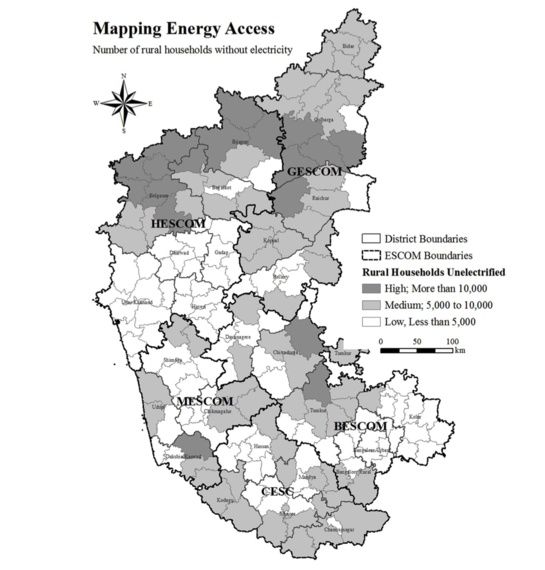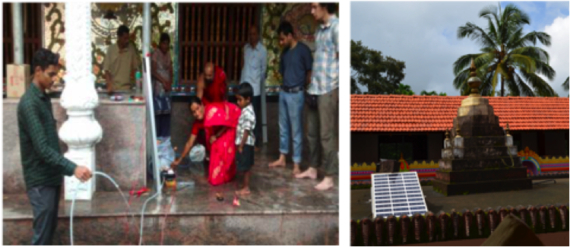By Vivek Shastry (Energy Analyst) and Sahar Mansoor (Policy Analyst) at SELCO Foundation
On 19 October, Chief Minister Siddaramaiah released the Human Development Index 2015 (HDI) for the gram panchayats (GP) of Karnataka, considering factors such as access to cooking fuels, toilets, safe drinking water and electricity. Half of the 5898 gram panchayats are performing above the state average GP HDI of 0.4392, but in the northern districts of Bagalkot, Bidar, Gadag, Kalburi, Raichur Yadgir and Vijayapura more than 90% of the GPs are below the average HDI figures.
This trend bears a strong resemblance to the level of electricity access, with more than 10,000 rural households in many taluks of Belgaum, Bijapur and Gulbarga districts still left in the dark. This highlights the significant regional imbalance in Karnataka's development trajectory. Energy poverty is a gripping issue affecting the availability and quality of basic health facilities, education, water and sanitation, housing etc. Without power, medicines cannot be refrigerated, machines cannot be operated and children cannot be regularly educated. In this situation, economies cannot be improved.
"Developing low carbon plans for villages will require a cross-sectoral approach that focuses on fostering the entire ecosystem necessary for creating sustainable livelihood opportunities and services..."
The new HDI data will enable the government to undertake better planning and fund allocation at village levels. Further, this presents a tremendous opportunity to undertake development through a low carbon pathway. The uncertainties associated with climate change highlight the need for a holistic and low carbon approach to development that can help build resilient communities, while also subverting the carbon-intensive development pathways that have been followed in the past.
Developing low carbon plans for villages will require a cross-sectoral approach that focuses on fostering the entire ecosystem necessary for creating sustainable livelihood opportunities and services that will uplift the standard of living in the long term. This requires looking beyond infrastructure development, and moving towards a convergence of schemes that create a conducive policy environment for decentralised energy, financial inclusion, sustainable livelihoods, health and education.
Image may be NSFW.
Clik here to view.
Regional imbalance in access to electricity in Karnataka (Census 2011): SELCO Foundation
For example, the central government's Saansad Adarsh Gram Yojana (SAGY) leverages the capacity of the MPs to transform villages into Adarsh Grams (model villages) of holistic development. The scheme envisages a participatory model that can bring together the gram panchayats, government organisations and private partners. Improving the communities access to financial institutions results in financial inclusion of first time borrowers who otherwise were excluded from accessing loans. Equal importance needs to be given for skill development and improving livelihood activities of the community (such as solar-powered sewing machines, solar-powered dairy cooperatives, solar driers etc).
One example of a model village is Haniya village in Hosa nagar taluk in Shimoga. Gram Bharathi Trust (GBT) contributed up to 30% of the total funds required and aggregated it with soft funding from the Applied Material Foundation (AMF) to provide a guarantee for bank loans. Against this guarantee, Pragathi Krishna Grameen Bank in Hosanagar provided loans to individual households for their systems. Now, more than 145 home-lighting systems, street lights, water purifiers, study lamps, computer lab and other community devices are powered by solar electricity.
Image may be NSFW.
Clik here to view.
A solar micro pump at a temple in Haniya
Such model village interventions integrate energy-related inputs in health, education, livelihoods and skill development, while also providing safe drinking water and low cost infrastructure facilities. There is ample scope in adopting a cross-sectoral approach in the field of development as there is a multiplicity of schemes and many have not produced desired results. The SAGY provides an opportunity for convergence of these schemes, with coordinated action and optimal utilisation of funds to realise economic, social and environmental goals.
On 19 October, Chief Minister Siddaramaiah released the Human Development Index 2015 (HDI) for the gram panchayats (GP) of Karnataka, considering factors such as access to cooking fuels, toilets, safe drinking water and electricity. Half of the 5898 gram panchayats are performing above the state average GP HDI of 0.4392, but in the northern districts of Bagalkot, Bidar, Gadag, Kalburi, Raichur Yadgir and Vijayapura more than 90% of the GPs are below the average HDI figures.
This trend bears a strong resemblance to the level of electricity access, with more than 10,000 rural households in many taluks of Belgaum, Bijapur and Gulbarga districts still left in the dark. This highlights the significant regional imbalance in Karnataka's development trajectory. Energy poverty is a gripping issue affecting the availability and quality of basic health facilities, education, water and sanitation, housing etc. Without power, medicines cannot be refrigerated, machines cannot be operated and children cannot be regularly educated. In this situation, economies cannot be improved.
"Developing low carbon plans for villages will require a cross-sectoral approach that focuses on fostering the entire ecosystem necessary for creating sustainable livelihood opportunities and services..."
The new HDI data will enable the government to undertake better planning and fund allocation at village levels. Further, this presents a tremendous opportunity to undertake development through a low carbon pathway. The uncertainties associated with climate change highlight the need for a holistic and low carbon approach to development that can help build resilient communities, while also subverting the carbon-intensive development pathways that have been followed in the past.
Developing low carbon plans for villages will require a cross-sectoral approach that focuses on fostering the entire ecosystem necessary for creating sustainable livelihood opportunities and services that will uplift the standard of living in the long term. This requires looking beyond infrastructure development, and moving towards a convergence of schemes that create a conducive policy environment for decentralised energy, financial inclusion, sustainable livelihoods, health and education.
Image may be NSFW.
Clik here to view.

Regional imbalance in access to electricity in Karnataka (Census 2011): SELCO Foundation
For example, the central government's Saansad Adarsh Gram Yojana (SAGY) leverages the capacity of the MPs to transform villages into Adarsh Grams (model villages) of holistic development. The scheme envisages a participatory model that can bring together the gram panchayats, government organisations and private partners. Improving the communities access to financial institutions results in financial inclusion of first time borrowers who otherwise were excluded from accessing loans. Equal importance needs to be given for skill development and improving livelihood activities of the community (such as solar-powered sewing machines, solar-powered dairy cooperatives, solar driers etc).
One example of a model village is Haniya village in Hosa nagar taluk in Shimoga. Gram Bharathi Trust (GBT) contributed up to 30% of the total funds required and aggregated it with soft funding from the Applied Material Foundation (AMF) to provide a guarantee for bank loans. Against this guarantee, Pragathi Krishna Grameen Bank in Hosanagar provided loans to individual households for their systems. Now, more than 145 home-lighting systems, street lights, water purifiers, study lamps, computer lab and other community devices are powered by solar electricity.
Image may be NSFW.
Clik here to view.

A solar micro pump at a temple in Haniya
Such model village interventions integrate energy-related inputs in health, education, livelihoods and skill development, while also providing safe drinking water and low cost infrastructure facilities. There is ample scope in adopting a cross-sectoral approach in the field of development as there is a multiplicity of schemes and many have not produced desired results. The SAGY provides an opportunity for convergence of these schemes, with coordinated action and optimal utilisation of funds to realise economic, social and environmental goals.